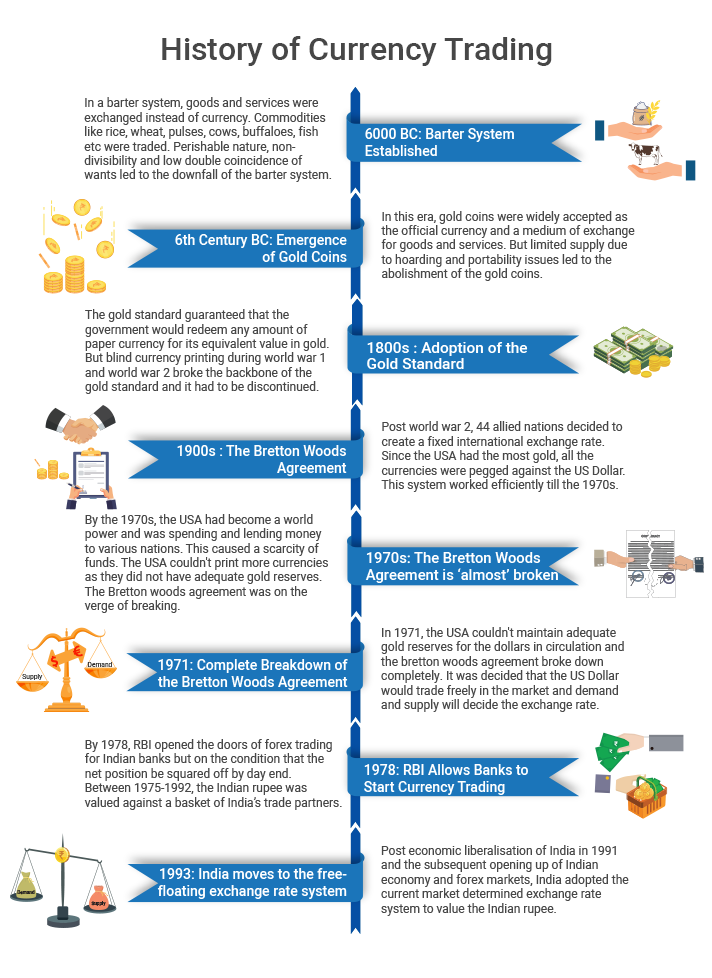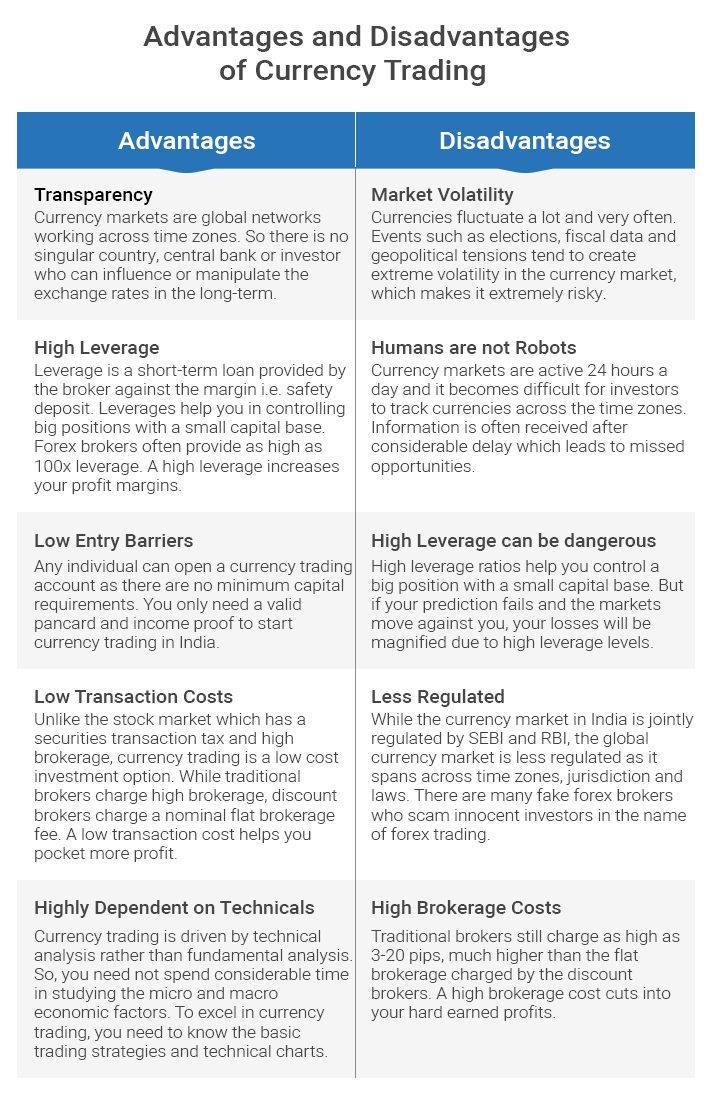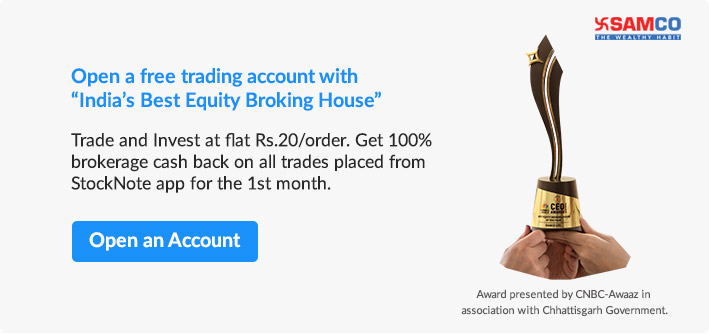What is Currency Trading or Forex Trading?
The average Indian investor has always avoided currency trading or forex trading, assuming it to be a complicated activity reserved only for the rich.
But this is far from the truth, especially since a common man is directly or indirectly involved in currency trading!
Currency trading in India is typically done through currency derivatives i.e. forex spot, forwards and futures contracts.
But lack of awareness about what is currency trading or forex trading and how to make money in currency trading has always been a major hurdle for active retail participation in currency trading in India.
In this article, we will understand the basics of currency trading in India and address the following questions:
-
» What is Currency Trading and Forex Trading?
-
» A brief history of the Forex markets
-
» What are the basics of Currency Trading?
-
» What are the advantages and disadvantages of Currency Trading?
-
» What are the risks associated with Currency markets and how to mitigate them?
-
» How to make money in the Forex markets?
-
» How to trade in the Currency markets?
-
» FAQs
What is Currency Trading and Forex Trading?
FOREX, short for Foreign Exchange, is a marketplace where national currencies are bought and sold. The forex market is also commonly referred to as FX, currency market or foreign exchange market.
Currency trading or Forex trading refers to buying and selling national currencies to either make profit, or hedge businesses against possible exchange rate ups and downs.
Every individual, from the hedge fund CEO to the Kirana shop owner near you or even you, directly or indirectly participate in currency trading in India. Let’s see how:
- If you are planning a trip to Paris, to pose beneath the Eiffel Tower, you will exchange your Indian rupees for Euros. This is known as Forex trading.
- The CEO of an investment firm wants to safeguard his client (an importer) against a rise in the UDS/INR rate, so he will use currency derivatives to protect his client, thereby indulging in currency trading.
- One of the yummiest potato chips, Pringles, is made outside India and has to be imported. So, every time you buy Pringles from your Kirana store, you are indirectly participating in Forex trading.
As per the 2019 Triennial Survey by the Bank for International Settlements (BIS), the daily turnover of the forex market was 6.6 trillion US Dollars, making forex the most actively traded market globally!
[Suggested Reading: How To Start Currency Trading in India]
With such high liquidity comes an unlimited potential for wealth creation and hence it would be foolish to ignore forex as part of your investment portfolio. But before we learn how to make money in forex trading, let us understand the origin of currency trading worldwide.
Currency Trading – Worldwide – A Brief History
The earliest references of currency trading dates back to 19th century BCE but the most notable currency trading systems can be traced back to:

-
6000BC: Barter System comes into existence:
In a barter system, commodities are traded against commodities. For example, if Ram has 1 kg rice and he wants to buy 1 kg wheat and Shyam has 1 kg wheat and wants to buy 1 kg rice, then Ram and Shyam will enter into a barter transaction and Ram would get the wheat and Shyam the rice. But issues like the perishable nature of commodities, non-divisibility etc. broker the barter system.
-
6th Century BC: Gold replaced the barter system:
We have all seen movies where the emperors would pay gold coins to their workers (Mughal-e-azam or Jodha Akbar) and these gold coins were then exchanged for commodities and other services. But again, portability, limited supply and divisibility led to the downfall of gold as a currency.
-
1800s: Adoption of Gold Standard:
Post the downfall of the gold coins, economies of the world decided to adopt the gold standard. A gold standard guaranteed that the country's government would redeem any amount of paper currency for its value in gold.
So, if RBI printed 1 Lakh notes of 10 Rupees each then it would maintain gold reserves worth Rs 10 Lakhs. And while this system promoted accountability, World War I and World War II broke its backbone when European countries began printing currencies blindly without maintaining their equivalent value in gold.
-
1900s: The Bretton Woods System:
Post World War II, 44 allied nations assembled and decided to create a fixed international currency exchange rate. Since the United States of America had the most gold, all the currencies were pegged against the US Dollar.This system functioned efficiently until the 1970s.
-
1970s: Cracks in the Bretton Woods System:
By 1971, the US faced monetary pressures due to its overseas involvement which resulted in increased government spending and lending.While they printed currency to fulfill the demand, they failed to back it up with equivalent gold reserves.
-
1971: Bretton Woods System completely shuts down:
In 1971, President Richard Nixon ended the Bretton Woods agreement and declared the Dollar to be a fiat currency. The European nations decided to maintain a single currency (the Euro) which would trade against the US Dollar. Subsequently all the other nations started the free-floating exchange rate determination mechanism against the US Dollar and established the current currency trading system.
-
Indian Rupee:
In 1978 RBI allowed banks to undertake intra-day trading in foreign exchange (although they had to maintain a near square position before end of trade). Between 1975-1992, the Indian currency was pegged to the weighted basket of currencies of India’s major trading partners. This method was replaced by the present form of “market-determined-exchange-rate” in 1993.
Basics of Currency Trading
With a global liquidity of 6.6 trillion US Dollars, the currency market is rich with profit making opportunities. Currency trading in India is done via currency derivatives contracts like forwards, futures, options and swaps.
Before we understand how currency derivatives work, let us first understand the basics of currency trading.
-
No central location:
The currency market has no central location and is an electronically connected network of traders across the globe. A trader in Britain and a trader in Ghatkopar can connect and trade in (GBP/INR) contracts. The currency market is the only market that stays open 24 hours a day, 5 days a week.
-
Currency pairs:
Currencies are always traded in pairs, like USD/INR (US Dollars: Indian Rupee), JPY/CHF (Japanese Yen: Swiss Francs) etc. There are 3 types of currency pairs
-
Major pairs:
The major currency pairs almost always involve USD i.e. (USD/EUR); (USD/GBP); (USD/CAD) etc.
-
Minor Pairs:
The minor currency pairs do not involve USD but peg other major currencies against each other like (JPY/CHF); (INR/JPY); (GBP/INR) etc.
-
Exotic pairs:
Exotic pairs are currency pairs which use 1 major currency and 1 minor currency like USD/NOV (US Dollars/Norwegian Krone).
-
-
Pip:
A point in price or pip is the smallest movement (change) in the valuations of the currency pair. For example if the USD/INR rate is 73.7502 today and it was 73.7501 yesterday, then the pip is 0.0001 (or 1 pip)
-
Base currency and quote currency:
In a currency pair, the currency on the left is base currency and the currency on the right is quote currency.
In the currency pair (USD/INR) USD is the base currency, whose value is always 1 and INR is the quote currency. So, if USD/INR is 73.75 it means that you can buy 1 US Dollar against 73.75 Indian rupees.
-
Bid & ask Price:
The price for buying the base currency is called Bid price and the price for selling the base currency is called Ask price.
So, if USD/INR is quoted as 73.7260/73.7230 then to buy 1 USD you need Rs 73.7230 and to sell 1 USD you will need Rs 73.7260.
-
Spread:
The difference between the bid and ask price is known as a spread. For example, if the bid/ask for USD/INR is 73.723/73.726 then the spread is 0.003 (73.7260-73.7230)
-
Leverage:
An important concept in forex trading is leverage. Leverage allows a trader to trade with more than what they have in cash.
For example, if you have Rs 10,000 in your trading account and your broker gives you 20:1 leverage then you can trade in currencies up to Rs 2 Lakhs. A leverage of 50:1 will allow you to trade up to Rs 5 lakhs against Rs 10,000 in your trading account.
-
Lots
Contrary to shares, currencies are traded in lots. There are 3 lot sizes namely, Micro lot (1,000 units); Mini Lot (10,000 units) and Standard Lot (1,00,000 units).
Basics of Currency Trading in India
- All currency contracts in India are speculative in nature i.e. you do not get the physical delivery of the currency. Currency trading in India is not allowed in cash for retail investors.
- Currency trading in India is allowed in the following pairs only: (USD/INR); (EUR/INR); (JPY/INR);(GBP/INR); (EUR/USD); (GBP/USD) and (USD/JPY).
- Forex trading is facilitated on the National Stock Exchange (NSE), Bombay Stock Exchange (BSE) & Metropolitan Stock Exchange of India Ltd.
- The Currency market is regulated by SEBI (Securities and Exchange Board of India) and RBI (Reserve Bank of India) jointly.
- The lot size for (USD/INR), (EUR/INR) & (GBP/INR) is 1,000 units whereas the lot size for (JPY/INR) is 1,00,000 units.
Advantages & Disadvantages of Currency Trading in India
Now that you understand the basics of the currency markets in India, let us look at the primary advantages and disadvantages of currency trading in India.

Advantages of Currency Trading in India
Low Entry Barriers:
Any person can open a currency trading account as there is no minimum capital requirement. Your broker will provide you leverage, which can go as high as 100X i.e. you can take positions up to Rs 10 Lakhs if you have Rs 10,000 in your currency trading account.
Leverage:
Leverage is simply a short-term loan provided by your broker against the amount in your trading account. With leverages ranging as high as 100x, a small trader can take major positions in the currency market and earn unlimited profits.
Transparency:
Since information on currency movements and interest rates is readily available in the market, there is little possibility of long-term insider price manipulation by central banks or market participants.
Low Transaction Costs:
In the equity markets, brokers charge a % on the total trade volume, which impacts your profit margin (Samco charges flat Rs 20/trade irrespective of the trade size). In currency trading, the spread i.e. difference between the bid price and ask price is the income for brokers.
Unlimited return potential with less reliance on fundamental analysis:
With factors such as a 24-hour market, high leverage, and a daily turnover of 6.6 trillion US Dollars you can make unlimited profits in the currency market. Also the currency market is more based on technical analysis rather than fundamental analysis. So, making profits is dependent majorly on your trading strategy rather than market fundamentals.
[Suggested Reading: The Top Forex Trading Strategies and how to implement them]
Disadvantages of Currency Trading in India
Market volatility:
Currencies fluctuate every second and the fluctuations are drastic during geopolitical tensions or elections. In such times, even a 1 or 2 adverse pip change can lead to huge losses for investors.
Also it is very difficult to predict these events hence it is important for traders to understand the market volatility, its factors and its effect before taking huge positions.
Humans are not robots:
While the Indian currency market closes at 5.00 pm every day, the global currency markets run 24 hours a day across time zones.
It becomes difficult for traders to track price movements through different time zones and often they miss out on good opportunities.
High leverages – a double-edge sword:
Excess of anything can be detrimental to your finances. While big leverages help you take big positions in the market, even a small adverse change can lead to huge losses. Hence it is very important to understand your risk appetite and manage money prudently.
Brokerage costs:
In currency trading, brokers make money via the spread. So, higher the spread, more will be your transaction costs. Traditional brokers charge as high as 3-20 pips, way higher than the 1 pip charged in interbank trades.
Discount brokers, like Samco, charge a flat fee structure. Samco charges as low as Rs 20/trade irrespective of the trade size.
You can read more on the benefits of opening a forex trading account with Samco here .
Less – regulated:
While the currency market in India is jointly regulated by RBI and SEBI, globally the currency market is way less regulated than the stock markets. The global currency market is dominated by banks and brokers, which can lead to scams, unfair price manipulations, counterparty risks etc.
Risks in Forex Trading and How to Mitigate them
Since you already understand the meaning of currency trading, its advantages and disadvantages, let’s also quickly cover the risks associated with Forex trading and how to mitigate them.
| Risk | How to mitigate them |
|---|---|
| Currency Fluctuation and Volatility | Currencies fluctuate based on economic data, geopolitical tensions between countries, fiscal deficits etc. To mitigate this risk, it is advisable to trade in major currencies like USD, GBP, JPY as their values do not experience high fluctuations. |
| High leverage | Leverage is a double-edged sword i.e. if your prediction is correct, a high leverage will lead to massive profits but in case your prediction fails, the quantum of loss will also be massive. Hence, always work with a strict Stop-Loss while dealing in currency markets and understand your risk appetite before trading. |
| Scams | There are many fake forex brokers in the Indian currency market and therefore you need to ensure that you open a trading account with a real SEBI registered and approved currency broker only, like Samco. |
| Counterparty risks | Legally, you can trade currencies only via NSE/BSE/MCX-SX in India. This ensures that the exchange in the counterparty and your counterparty default risk is eliminated. |
How to Create Wealth with Currency Trading in India
Finally, let us understand how you can create wealth through currency trading in India.

Mr. Ram, a teacher in a government school decided to try his luck in currency trading and opened a currency trading account with Samco – one of the best currency brokers in India. He deposited Rs 1,00,000 in his trading account.
He expects the Indian Rupee (INR) to weaken against the US dollars and decides to buy a 1 month (USD/INR) futures contract at Rs 72.056.
Since he has Rs 1,00,000 in this trading account, based on margin calculations (calculate here ) he could buy 43 lots.
So he took a position worth Rs 30.98 Lakhs against an account balance of 1 lakhs (a leverage of 31x).
After a week, his prediction came true and the USD/INR was valued at Rs 72.574. He decided to sell his 43 lots, making a profit of Rs 22,274 within a week!
Imagine a profit of Rs 22,274 in 1 week! Wouldn’t you want this kind of wealth? If yes, try Samco’s currency trading platform today!
But remember, the markets are unpredictable and can move against you at times. So, while you can make money in the forex markets, if your prediction fails, you can also incur losses. Therefore it is recommended to trade in the forex markets with a strict stop-loss.
[Suggested Reading: The Top 10 Tips for Forex Trading in India]
How to Start Successful Forex Trading in India
Forex trading is the act of buying and selling currency pairs to profit from a change in their exchange rates. To successfully make money via forex trading in India, you need to correctly predict the exchange rate movements.
Apart from this, you need to have a trading account with a SEBI registered currency broker in India, like Samco. That’s it! It’s that simple.
In addition to being a SEBI registered currency broker in India, Samco also provides the following facilities in currency trading:
- Currency trading at lightning speed.
- High Leverage
- In this fast paced world, Samco provides an even faster trade-on-the-go facility from anywhere and everywhere.
- Call & Trade facility
- Diverse trading strategies and facilities
You can read our detailed article on how to open a forex trading account in just 5 minutes with Samco.
So, open the best forex trading account in India with Samco today and start creating wealth with currencies!







 Easy & quick
Easy & quick